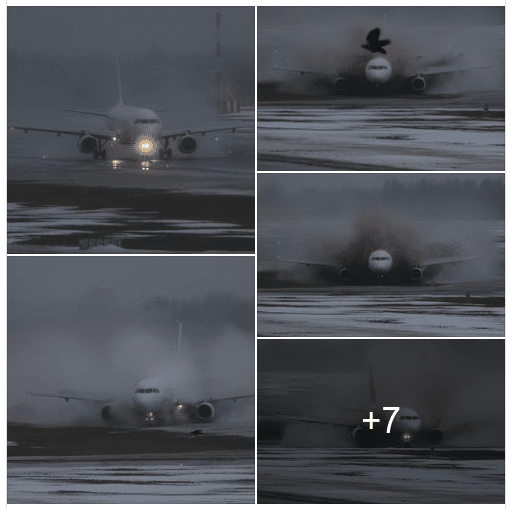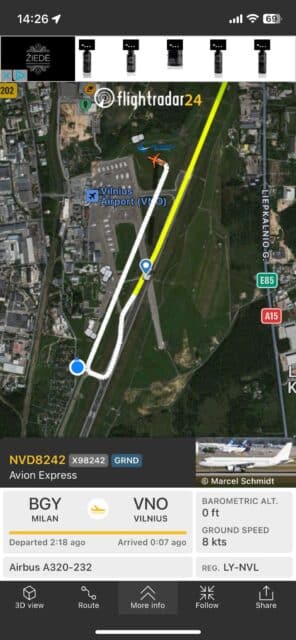
On the 3rd of February 2024, an Airbus A320-200, registered in Lithuania as LY-NVL, departed the runway upon landing at Vilnius, Lithuania. This was an Avion Express flight, an operator based in Vilnius that offers seasonal flights to Egypt and performs charter flights for tour operators.
Flight NVD8242 was a chartered passenger flight from Milan, Italy, to Vilnius, with 179 passengers and six crew on board.
The weather that day was overcast with clouds at 300 feet above ground level. Visibility was 5,000 metres and wind coming from 280° at 13 knots.
Vilnius Airport has a single runway made of asphalt concrete, 01/19, which is 2,515 meters long and fifty metres (164 feet) wide. Unfortunately, that wasn’t quite wide enough.
The runway in use that day was Runway 19 (approximately south), meaning that the wind from 280° (approximately west) and the poor weather made for a challenging landing. The Airbus seemed to touchdown just fine but once on the runway, it abruptly veered off the runway for some off-roading in the mud.
A passenger told LRT.lt, “When the plane landed on the grass, mud began to spray on its windows; you couldn’t see anything through them anymore.”
This might be an artifact of the translation, but the aircraft didn’t actually land on the grass. I don’t know any Lithuanian speakers so I had to make do with machine translation, but if you speak Lithuanian, please feel free to correct me in the comments. In any event, the aircraft clearly landed on the runway and then swerved off.
This image from FlightRadar24 clearly shows the deviation from the runway.
It looks like just a slight deviationg but you can get a better idea of what happened from this unattributed video posted to Twitter, which shows the aircraft as it leaves the runway. Someone’s added music so you might want to turn the sound off before watching:
An Avion Express A320-200 landing at Vilnius Airport briefly skidded off the runway, onto the grass and mud, before safely returning to the runway to continue its dirty taxi to the apron.
📹 Unkown/DM for creditbuiltairbustough AvionExpress avion #a320 airbus pic.twitter.com/JQPF9iCZLs
— A Fly Guy’s Crew Lounge (@AFlyGuyTravels) February 4, 2024
That first still in the sequence isn’t from the same person (and was probably used without permission).
That photograph was taken by aviation photographer Benas Kontautas, who lives in Vilnius. He was lucky enough to be in exactly the right place and the right time to get an amazing series of the Airbus spraying mud as it continued alongside the runway. He posted the photographs to Facebook.
If you don’t have Facebook, you can also see the photographs by Kontautas in this LRT.lt gallery.
The Airbus A320 returned to the asphalt and continued travelling to the next turn-off, where it taxied to the apron.
This two-minute video (without music! hurray!) shows the full sequence, starting with the Airbus touching down and landing. At the forty-second mark, it drifts across the runway and begins to spray the mud and water. The aircraft comes to a halt and then the engines power back up to carefully return onto the runway.
VASAviation has the interchange between the aircraft and Vilnius Tower overlayed with footage of the aircraft coming off the runway at 1:21. It’s worth a listen just to hear the dry tones of the exchange between the flight and the controller.
The controller and the flight crew had been speaking to each other in English up until this point.
Tower: “Nordwind 8242”
Nordwind 8242: “Atsakom.” Go ahead.
Tower: “Ehm, matau jūs nuslydote nuo [unintelligible].” Um, I see you’ve slipped off the runway.
Nordwind 8242: “Tikrai taip.” Indeed, yes.
Tower: “Kokios pagalbos reikia?” What help do you need?
Nordwind 8242: “Kol kras nereikia.” No assistance needed at the moment.
The aircraft returns to the runway.
Tower: (switching back to English) “Nordwind 8242, are you able to taxi on your own power or do you need any assistance?”
Nordwind 8242: “[unintelligible] able on our own power, Nordwind 8242”
Tower: “Okay…continue via Echo, Foxtrot and then left to Juliet, stand 207.”
I can just imagine Maintenance listening to this and thinking, Um?
A passenger in good spirits took a video while still in the cabin, showing a brief view of the mud on the windows and then, as they disembark, the grass under the fuselage of the aircraft. There were no injuries.
The runway was closed for a detailed inspection. As Vilnius Airport has only one runway, this means that the airport was closed for about three hours. Inbound flights were diverted to Kaunas and Palanga airports.
Photographs taken the following day show the panels of the fuselage ripped off of the fuselage.

There have been some very snide comments about this being the result of pay-to-fly airlines, which I think is not reasonable. Pay-to-fly schemes are run by some airlines where professional pilots are expected to pay the airline for the privilege of being a part of the flight crew. The justification is that the pilot gains experience and possibly a type-rating by paying to fly for the airline. This can cost the pilot from 14,000€ to 85,000€ for 500-hours flight time.
Pay-to-fly schemes are considered by many, including me, to be a dubious practice. However, although it is a contentious issue, in most countries, there is no regulation to stop this practice. In France, the very idea of an employee paying to work for the employer is illegal. In the US, there are minimum requirements that the pilot must have already achieved before being able to pay to fly with an airline. Most civil aviation authorities have been silent on the question of whether pay-to-fly is unsafe or exploitative, including Lithuania. Lithuanian operator Small Planet Airlines was confirmed in 2015 as offering a pay-to-fly scheme; the Lithuanian aviation authority revoked its operations license in 2018, but not for that reason.
However, I did not find any direct references to Avion Express, who was the operator of this flight, using pilots hired under pay-to-fly schemes. Their website shows normal recruitment promising long-term contracts and competitive payment. There’s no evidence that the flight crew on this flight were anything other than experienced pilots hired under normal contracts, although likely underpaid.
I was pleased to see a poster on PPRuNe comment about some of the negative assumptions about the pilots.
I hate to spoil the “have a pop at the new generation” thing, but I know of a case in the ’80s where, not only did the crew not admit they’d been off piste, but due to low viz, the tracks on the grass were only discovered by Ops in the morning, when the aircraft was tucked up on stand, looking a bit sorry for itself. There’s nothing new under the sun…
Amazing. I’d love to track that one down!
Discover more from reviewer4you.com
Subscribe to get the latest posts to your email.



